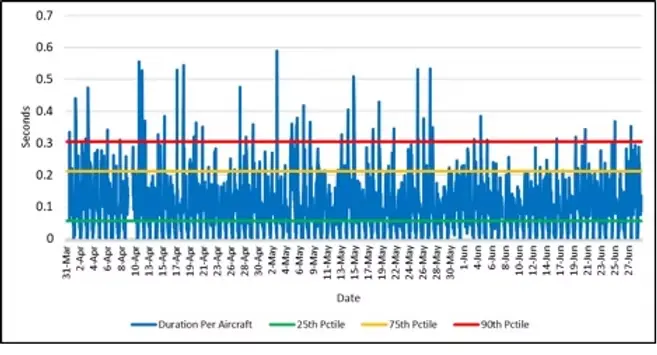Aviation Safety Monitor Weekly Report for the Week Ending June 29, 2024
Safety margins at the 26 monitored airports remained at good levels during the past week. The seasonal pattern of good safety margins during the spring and summer months continued. However, encroachment durations increased by double-digit percentages for the second consecutive week. More concerning is the continued increase in the more severe Category A and B separation conformance deviations that are now at the highest weekly level since we started reporting back in February 2024.

Welcome back to the Weekly Aviation Safety Report. Every Monday Robust Analytics reports on safety margins at 26 United States airports. With this Aviation Safety Monitor Weekly Report, Robust Analytics offers the aviation community timely assessments of changing safety margins and safety-related events. Dates and times are tracked in UTC and the week ends at midnight every Saturday. This week’s report includes data through 2400 UTC on June 29, 2024.
For New Readers: Please read our article “Did Safety Degrade in the National Airspace System in the Winter of 2022-2023?” that applies our methods and data to examine whether safety margins decreased during the events of winter 2022-2023.
The Aviation Safety Monitor measures safety margins by estimating the frequency, duration, and severity of buffer encroachments. Our paper “How Do We Measure Safety Margins?” provides a detailed description of the methods and data. That article can be found here https://www.robust-analytics.com/measure on the Robust Analytics website.
Weekly Safety Margin Update. Safety margins decreased over the past week although they remained at the good levels of the past couple of months, continuing the high safety margins that we typically observe during the summer months. Total encroachment durations for the week ending June 29 increased 14.0 percent from the previous week. That is the second consecutive week with double-digit percentage increases in buffer encroachment durations and weekly durations were at the highest level since the week ending May 11. The number of encroachment events decreased slightly, dropping by 2.7 percent. Average encroachment durations for the month of June were 6.3 percent lower than in May, with event counts falling one percent. The months-long trend with lower duration per event reversed the past two weeks, with the weekly encroachment duration per event increasing to 20.8, which is still well below the long term average duration per encroachment of 26.3 seconds. Figure 1 displays weekly summary metrics for the 26 monitored airports.

Figure 1. Weekly Trends in Encroachment Events and Durations
Let’s now take a closer look at safety margins for the seven days ending June 29. Figure 2 displays estimates of encroachment durations per aircraft for each hour over the previous seven days. This offers a detailed look at how safety margins vary over the operating day. Figure 2 also indicates the historical range of the data by showing the 25th, 75th, and 90th percentile values of the duration per aircraft metric. The percentiles were estimated using data from May 2022 through February 2024.
Figure 2 displays the typical time of day pattern that we observe in the data, as encroachment events are highly correlated with traffic density. Even after aggregating the data over 17 metroplexes operating in three time zones the time of day pattern remains prominent. We also observe a frequently-repeated pattern of daily peaks increasing early in the week and then declining. The week ending June 29 was not as quiet as the previous week, with more frequent spikes above the 75th percentile (14 over the 7-day period) and three hourly values above the 90th percentile.

Figure 2. Hourly Encroachment Duration Per Aircraft for the Week Ending June 29, 2024
Figure 3 shows duration per aircraft for the four weeks from May 26 through June 29, 2024. Over this longer time period the increased durations for the past two weeks are noticeable. However, even with a few more periods with encroachment durations above the 75th and 90th percentiles, the number remains a low fraction of all observations.

Figure 3. Hourly Encroachment Duration Per Aircraft for June 2 to June 29, 2024
Trends are easier to detect visually with the moving average plots shown in Figure 4. The chart reinforces the observation about Figure 3 that safety margins over the past month are much better than the historical average. This reflects a seasonal pattern in which safety margins are highest during the spring and summer months and that general pattern continues this month.

Figure 4. Moving Average Hourly Encroachment Duration Per Aircraft, June 2 to June 29, 2024
Figure 5 shows a longer perspective with three months of data back to March 31, 2024. This longer perspective makes clear the overall reduction in the level and peaks since March and April.

Figure 5. Hourly Encroachment Duration Per Aircraft, March 31, 2024 to June 29, 2024
Figure 6 displays the moving average version for the past three months. Encroachment durations dropped from early April but up until the past two week, but remain low and below the long run average.

Figure 6. 24-Hour Moving Average Encroachment Duration Per Aircraft for the Three Months Ending June 29, 2024
We wrap-up this week’s report with updates to the two charts presented in the previous weekly reports. Figure 7 shows the total daily counts of the number of encroachments and their durations across the 26 airports in the 17 metropolitan areas that we monitor. The blue bars report estimates of total daily encroachment durations divided by the number of aircraft in the terminal airspace (approximately 50 miles of the airport center) for all 17 terminal airspaces. The red line reports the daily number of encroachment events per 100 aircraft.

Figure 7. Encroachment Duration Per Aircraft and Event Rates for 26 Airports
February 18, 2024 through June 29, 2024
As data are added to the chart each week, readers can begin to detect some mild day-of-week variation and, more importantly, periods of a few days and even a week or longer in which encroachment durations increase significantly. In the coming weeks, we will examine these fluctuations in more detail.
How severe are these encroachments? The FAA defines three separation conformance categories based on how far they are from the separation index. (See the description “How Do We Measure Safety Margins?” for details on the conformance categories and how we measure them.) In that classification system, Conformance Categories A and B are the most severe. Under our definition of a buffer encroachment, Category A and B encroachments are counted under all meteorological conditions.
Figure 8 displays information on the most severe separation conformance categories. The daily durations and event counts for the sum of Category A and B encroachments are shown in Figure 7. The upward drift since the start of May continued over the past week. The weekly total encroachment durations for Categories A and B are now at the highest level since we began reporting in the Aviation Safety Monitor. What we observe is overall encroachment durations remaining relatively flat, but with a shift from the mild PE and Category C events to the more severe Category A and B events. This shift highlights the importance of calculating several metrics monitoring all events The Aviation Safety Monitor research team will continue to monitor this negative trend over the coming weeks. We will take a deep dive into the conformance category encroachments in a future weekly report.

Figure 8. Encroachment Durations and Event Counts for Conformance Categories A and B February 18, 2024 through June 29, 2024
Overall, at the NAS level safety margins have been stable for the past several weeks. The industry shows evidence of recovering from the stress of September 2022 to February 2023. We will take a deeper dive into that time period and the subsequent partial recovery in future reports.
The Aviation Safety Monitor summarizes output from Risk Tracker, the Robust Analytics in-time terminal airspace hazard and safety metrics monitoring system.

About the Aviation Safety Monitor
The Aviation Safety Monitor is a service provided by Robust Analytics to deliver timely information on terminal area safety in the National Airspace System (NAS). The safety monitoring and prediction technologies were developed by Robust Analytics over the past several years. Partial funding was provided by the NASA Small Business Innovation Research Program and the NASA System Wide Safety Project.
The Aviation Safety Monitor provides quantitative estimates of safety margins at 26 airports in 17 metropolitan regions in the United States. This information complements data on several safety-related events that are published elsewhere, with the FAA’s Runway Incursion Statistics website a good example. However, the available safety information can be misleading if it only reports the frequency of violations with no insight into how safety buffers may vary minute-to-minute and day-to-day. The Aviation Safety Monitor aims to provide this insight every week.
